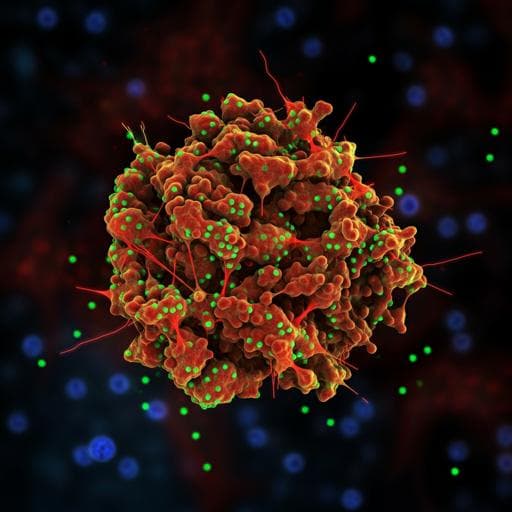
Medicine and Health
Identification of a highly stable bioactive 3-hydroxyproline-containing tripeptide in human blood after collagen hydrolysate ingestion
Y. Taga, Y. Iwasaki, et al.
This groundbreaking study reveals the presence of the Gly-3Hyp-4Hyp tripeptide in human blood after consuming porcine skin collagen hydrolysate. Its notable resistance to peptidase allows it to remain effective for hours. Conducted by Yuki Taga, Yu Iwasaki, Chisa Tometsuka, Noriko Funato, Yasutaka Shigemura, and Masashi Kusubata, this research highlights its potential health benefits, including promoting skin and bone health.
~3 min • Beginner • English
Introduction
The study addresses the oral bioavailability, fate, and bioactivity of 3-hydroxyproline (3Hyp)-containing oligopeptides derived from collagen hydrolysate. While numerous studies have shown that 4Hyp-containing di- and tripeptides (e.g., Pro-4Hyp, 4Hyp-Gly) appear in human blood at micromolar levels following ingestion and have diverse biological activities affecting skin, bone, and joint health, the absorption and function of 3Hyp-containing peptides remained unexplored. Given that 3Hyp is a rare collagen modification occurring at the Xaa position only adjacent to 4Hyp and varies by tissue and species, the study aims to identify 3Hyp-containing peptides in blood after ingestion, characterize their pharmacokinetics and stability, and assess their bioactivities relevant to skin fibroblast chemotaxis and osteoblast differentiation. Understanding these could explain part of the beneficial effects of collagen hydrolysate ingestion and reveal new bioactive peptide candidates.
Literature Review
Prior work established that ingestion of collagen hydrolysates results in high blood levels of 4Hyp-containing di- and tripeptides (notably Pro-4Hyp and 4Hyp-Gly), which resist proteolysis and are absorbed via peptide transporters. These peptides exhibit bioactivities such as stimulating fibroblast growth, chemotaxis in fibroblasts and neutrophils, and promoting osteoblast differentiation, potentially mediating clinical benefits of collagen supplementation for bone, joint, skin, and other conditions. Hydroxylation of proline (especially 4Hyp at Yaa) stabilizes peptides against digestion; a minor modification, 3Hyp at Xaa, occurs only adjacent to 4Hyp and varies widely by source, but its absorption and function have not been studied. Aminopeptidase P is implicated in the slow degradation of X-Pro/Hyp N-terminal bonds. Some collagen-derived peptides are taken up by tissues and cells, suggesting systemic and local actions. This context motivated investigation of 3Hyp-containing peptides, particularly Gly-3Hyp-4Hyp.
Methodology
- Human ingestion study: Eight healthy volunteers fasted 12 h and ingested 5 g porcine skin collagen hydrolysate (average MW 3000–5000 Da) in 100 mL water. Venous blood was collected at 0, 0.5, 1, 2, 4, and 6 h. Plasma was prepared and stored at −80 °C.
- Quantification of free vs peptide-form 4Hyp/3Hyp: Plasma was deproteinized with ethanol. Free Hyp was measured directly; total Hyp (free + peptide-form) measured after acid hydrolysis (6 N HCl/1% phenol, 110 °C, 20 h). Both were derivatized with APDS to enable separation of 4Hyp and 3Hyp, then analyzed by LC-MS/MS in MRM mode using stable isotope-labeled collagen (SI-collagen) standards. Peptide-form Hyp was calculated by subtraction (total − free).
- Identification and quantitation of 3Hyp-containing peptides: Candidate di-/tripeptides (Gly-3Hyp, 3Hyp-4Hyp, Gly-3Hyp-4Hyp, 3Hyp-4Hyp-Gly) were screened in 1 h post-ingestion plasma by LC-MS/MS MRM using synthetic standards. Time-course quantitation of selected Hyp-containing peptides, including Gly-3Hyp-4Hyp and major 4Hyp-containing peptides, used a stable isotope-labeled digest (SI-digest) internal standard and Ascentis Express F5 HPLC column; AUC calculated by trapezoidal rule.
- Peptidase/protease resistance assay: Synthetic peptide mixtures (Gly-3Hyp-4Hyp/4Hyp-Gly/Pro-4Hyp; Gly-3Hyp/Gly-Pro; 3Hyp-4Hyp/Pro-4Hyp) were incubated with fresh mouse plasma (20 μg/mL each) at 37 °C for 4–48 h. After deproteinization, residual peptides were quantified by LC-MS/MS MRM; residual ratios were calculated relative to 0 h.
- Mouse oral administration study: Collagen purified from bovine skin or Achilles tendon was characterized for Pro, 4Hyp, and 3Hyp content (residues/1000). Both were converted to gelatin and hydrolyzed with pancreatin (1:100, 37 °C, pH 8.1, 16 h); average MWs assessed by SEC (skin 1880 Da, tendon 1771 Da). Male ICR mice received 20 mg collagen hydrolysate (500 μL of 40 mg/mL) by gastric sonde after switching to a collagen-free diet. Blood was collected at 0–12 h. Plasma Pro-4Hyp, 4Hyp-Gly, and Gly-3Hyp-4Hyp were quantified by LC-MS/MS MRM with SI-digest. Statistics: one-sided Student’s t test.
- Fibroblast chemotaxis assay: Human skin fibroblasts in a FluoroBlok transwell were exposed in the lower chamber to 200 nmol/mL of Pro-4Hyp, Gly-Pro-4Hyp, or Gly-3Hyp-4Hyp (gelatin-coated membrane). After 18 h, migrated cells were labeled with calcein-AM and counted by fluorescence microscopy. Statistics: one-way ANOVA with Dunnett’s test.
- Osteoblast differentiation assays: MC3T3-E1 pre-osteoblasts were cultured in osteogenic medium with 200 nmol/mL peptides for 6–7 days. ALP activity assessed by NBT/BCIP staining (day 6); mineralization by alizarin red (day 7). Statistics: one-way ANOVA with Dunnett’s test.
- Ethics: Human and animal studies approved by the Experimental Ethical Committee of Nippi Research Institute of Biomatrix.
Key Findings
- After ingestion of porcine skin collagen hydrolysate, both free and peptide-form 4Hyp increased in plasma, with 4Hyp predominantly in free form. For 3Hyp, peptide-form levels exceeded free 3Hyp, with a delayed peak (2 h vs 1 h for peptide-form 4Hyp) and sustained elevation up to 6 h.
- LC-MS/MS identification showed Gly-3Hyp-4Hyp as the major 3Hyp-containing peptide in plasma; other candidates (Gly-3Hyp, 3Hyp-4Hyp, 3Hyp-4Hyp-Gly) were minimal or undetectable.
- Pharmacokinetics in humans (n=8): Gly-3Hyp-4Hyp exhibited a delayed Tmax and prolonged persistence compared to other Hyp-containing peptides. From Table 1: Gly-3Hyp-4Hyp AUC0–6h 2.77 ± 0.58 nmol/mL·h; Cmax 0.62 ± 0.14 nmol/mL; Tmax 2.63 ± 1.19 h. It ranked fourth in AUC among measured peptides, after Pro-4Hyp (AUC 34.18), Ala-4Hyp (5.10), and 4Hyp-Gly (4.82).
- Stability: In mouse plasma at 37 °C up to 48 h, Gly-3Hyp-4Hyp remained completely intact, while 4Hyp-Gly and Pro-4Hyp gradually decreased to less than half by 48 h. Gly-3Hyp was entirely stable; Gly-Pro degraded rapidly. 3Hyp-4Hyp degraded gradually similarly to Pro-4Hyp. The central 3Hyp in the Gly-3Hyp sequence confers exceptional resistance to peptidase/protease digestion.
- Mouse oral administration (skin vs tendon collagen hydrolysates; n=5): Pro-4Hyp and 4Hyp-Gly profiles were similar between sources. Gly-3Hyp-4Hyp was significantly higher with tendon hydrolysate (which had higher 3Hyp content: 3.2 vs 0.8 residues/1000 in skin). From Table 2: Gly-3Hyp-4Hyp AUC0–12h 2.73 ± 1.72 vs 1.26 ± 0.16 nmol/mL·h (P < 0.05); Cmax 0.41 ± 0.27 vs 0.15 ± 0.03 nmol/mL (P < 0.05); Tmax 3.60 ± 0.89 vs 2.80 ± 1.10 h.
- Bioactivity: At 200 nmol/mL, Gly-3Hyp-4Hyp significantly enhanced human skin fibroblast migration (~2.9-fold over control) and increased MC3T3-E1 ALP-positive area (~2.2-fold), and uniquely enhanced mineralization. Under the same conditions, Pro-4Hyp and Gly-Pro-4Hyp did not show statistically significant effects in these assays.
- Overall, most 3Hyp absorbed into blood after ingestion was in the Gly-3Hyp-4Hyp tripeptide form, explaining its relatively high plasma concentrations despite low 3Hyp abundance in collagen.
Discussion
The study demonstrates that the 3Hyp-containing tripeptide Gly-3Hyp-4Hyp is highly bioavailable and persists in circulation after oral collagen hydrolysate ingestion, addressing the previously unexplored fate of 3Hyp in vivo. Its delayed Tmax and sustained levels contrast with other 4Hyp-containing peptides and are explained by extraordinary resistance to plasma peptidases/proteases, chiefly due to the N-terminal Gly-3Hyp motif. Aminopeptidase P likely contributes to the slow degradation of other collagen peptides (X-Pro/Hyp at the N-terminus), but appears unable to cleave the Gly-3Hyp bond efficiently, conferring unique stability. Mouse studies show that selecting collagen sources richer in 3Hyp (e.g., tendon) significantly elevates systemic Gly-3Hyp-4Hyp exposure. Gly-3Hyp-4Hyp’s chemotactic activity on skin fibroblasts and promotion of osteoblast differentiation suggest tissue-relevant actions analogous to those proposed for 4Hyp-containing peptides, with potential roles in wound healing and bone remodeling. Given reports of tissue uptake of collagen-derived peptides and endogenous generation during tissue remodeling, Gly-3Hyp-4Hyp may act as a signaling molecule produced from dietary or endogenous collagen, potentially in autocrine/paracrine contexts, especially in tissues with higher 3Hyp (e.g., type IV collagen-rich basement membranes). The findings broaden understanding of collagen peptide bioactivity beyond 4Hyp-containing species and point to source selection to modulate bioactive peptide profiles.
Conclusion
This work identifies Gly-3Hyp-4Hyp as the predominant 3Hyp-containing peptide appearing in blood after collagen hydrolysate ingestion, with pharmacokinetic features of delayed Tmax and prolonged persistence due to exceptional proteolytic stability. The peptide exhibits bioactivities relevant to skin and bone (fibroblast chemotaxis and osteoblast differentiation) and its systemic levels can be enhanced by using collagen sources richer in 3Hyp (e.g., tendon). These findings suggest Gly-3Hyp-4Hyp is a significant contributor to the health benefits associated with collagen hydrolysate and a promising candidate for therapeutic or nutritional applications. Future research should investigate mechanisms of intestinal transport and tissue uptake, in vivo efficacy and safety, receptor/partner interactions, dose–response relationships, and the impact of diverse collagen sources (including invertebrates with higher 3Hyp) on systemic exposure.
Limitations
- Human study sample size was small (n=8) and limited to a single dose and source (porcine skin), which may limit generalizability.
- Stability assays used mouse plasma in vitro; in vivo human metabolism may differ.
- Tissue distribution, cellular uptake, and receptor/mechanism of action for Gly-3Hyp-4Hyp were not directly assessed; conclusions about in vivo bioactivity are based on in vitro assays.
- The transporter(s) mediating intestinal absorption of Gly-3Hyp-4Hyp were not identified; pharmacokinetics beyond 6 h in humans were not measured.
- Affinity and specificity of potential degrading enzymes (e.g., aminopeptidase P) for 3Hyp-containing bonds were inferred but not directly tested biochemically in this study.
Related Publications
Explore these studies to deepen your understanding of the subject.







